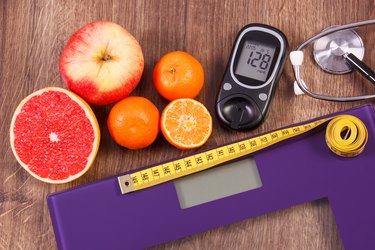
Some people with type 2 diabetes benefit from losing weight (and maintaining that loss) to help manage their blood sugar. While the primary focus should be on getting plenty of lean proteins, non-starchy vegetables and whole grains, you can enjoy other foods you may have previously considered off-limits.
One of the common diet myths for people with diabetes is that all starches, including starchy vegetables like corn, need to be avoided. The truth is, however, that corn and diabetes aren't mutually exclusive — as long as you keep the serving size in mind.
Video of the Day
Video of the Day
Tip
Cooked corn, both on the cob and off, is good in moderation for people with diabetes.
Carbs in a Diet for Diabetes
Everyone needs carbs to fuel their bodily functions, but the amount of carbohydrate you require daily depends on factors like your sex, weight and physical activity.
A dietitian can help you arrive at a number that works for you. In general, though, most adults with diabetes should aim for no more than 200 grams of carbs a day, according to the U.S. National Library of Medicine.
Diabetes statistics show that about 34 million American adults have the condition, per the Centers for Disease Control and Prevention (CDC). A healthy diet for people with diabetes is virtually identical to a healthy diet for anyone, according to the American Diabetes Association. Whole foods rather than processed foods work best for health. To that end, people with diabetes should focus on foods low in saturated fat, sugar and sodium, and select lean proteins like fish and chicken; non-starchy vegetables like broccoli, cauliflower, spinach and cucumbers; fruits; whole grains; and healthy fats most often.
That said, starchy foods are not off the menu; you just need to pay close attention to serving size. The serving size for starchy vegetables like corn or potatoes is 1/2 cup cooked, while 1/3 cup cooked is the serving size for starches like rice and pasta.
As a visual aid, if you divide a 9-inch plate into quarters, you would fill one quarter with lean protein like baked salmon or chicken breast, another quarter with a starch like corn or brown rice and the remaining half of the plate with non-starchy vegetables like steamed broccoli, cauliflower or greens.
Corn and Diabetes
If you count carbs as part of your eating plan, a half-cup serving of sweet cooked corn gives you about 16 grams of carbs, while a small ear about 6 inches long contains approximately 19 grams, per the USDA.
For those who consult the glycemic index when choosing carbs — a tool for measuring how quickly a carb-containing food converts to glucose — sweet corn falls into the "moderate" GI category, with one serving receiving a 52 on the scale, according to Harvard Health Publishing.
Be aware, though, of unhealthy additions to your cooked corn, like butter and salt, which add saturated fat and sodium to your vegetable. Try enjoying your serving of corn with a dab of a plant-based butter substitute and fresh herbs like basil or cilantro.
You can also enjoy other foods containing corn, like air-popped popcorn, which has 6 grams of carbs in a cup; and popcorn cakes, which contain 8 grams in a one-cake serving. For all processed foods with corn, check the nutrition label for their carb content.
As part of a healthy diet, corn delivers other valuable nutrients like fiber, for digestive health; vitamin A, for eyes and skin; and B-family vitamins, which benefit nerve and brain health.
- American Diabetes Association: "Diabetes Myths"
- U.S. National Library of Medicine: "Counting Carbohydrates"
- National Institute of Diabetes and Digestive and Kidney Diseases: "Diabetes Diet, Eating, and Physical Activity"
- Harvard Health Publishing: "Glycemic Index for 60+ Foods"
- MyFoodData: "Popcorn Cakes, Air-popped Popcorn"
- CDC: "National Diabetes Statistics Report 2020"
- American Diabetes Association: "Understanding Carbs"
- USDA FoodDate Central: "Corn, sweet, yellow, cooked, boiled, drained, without salt"


